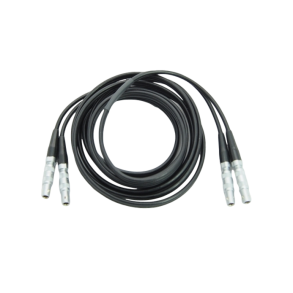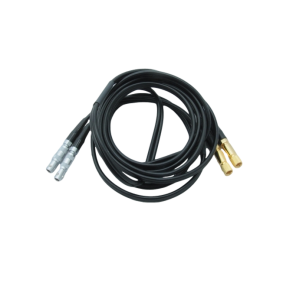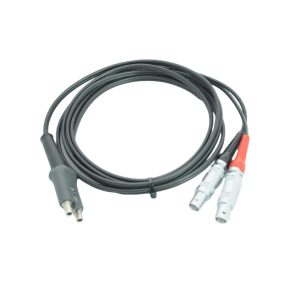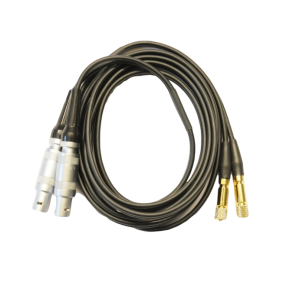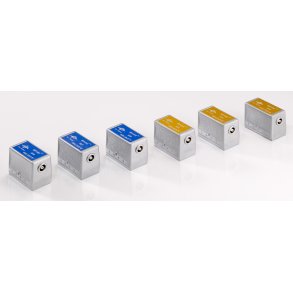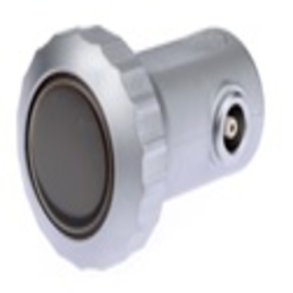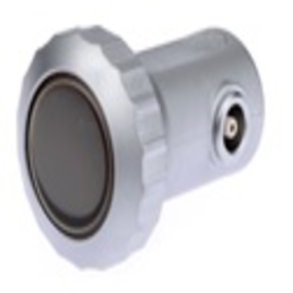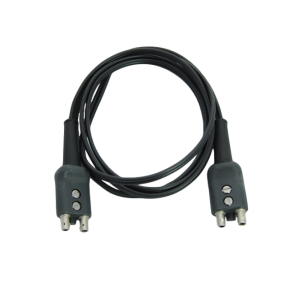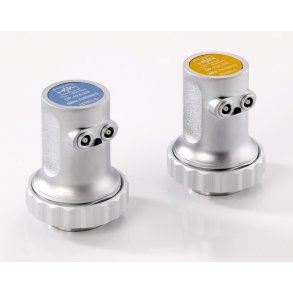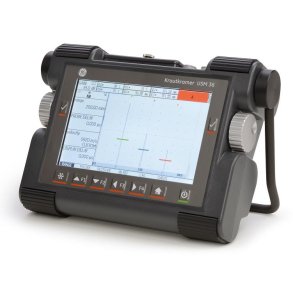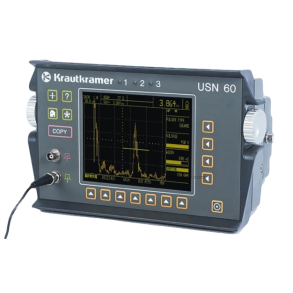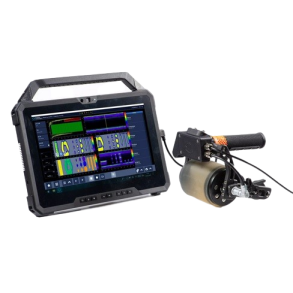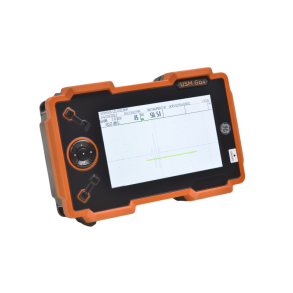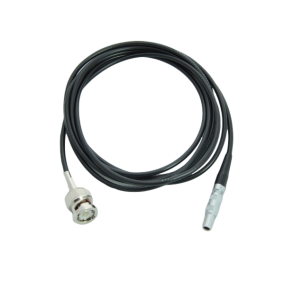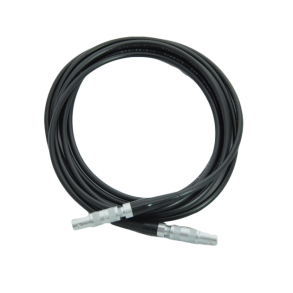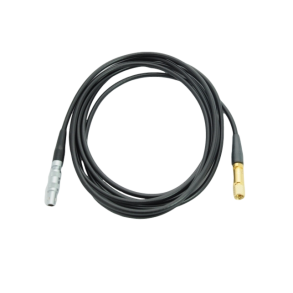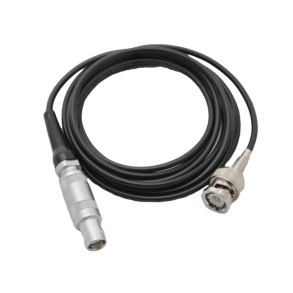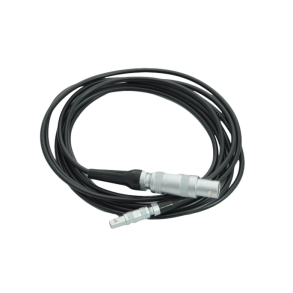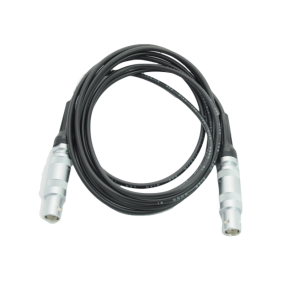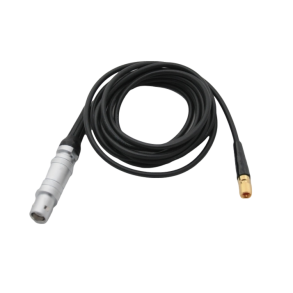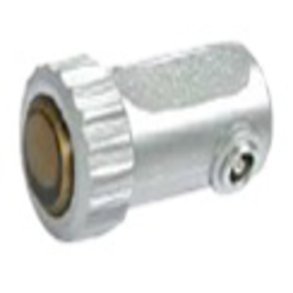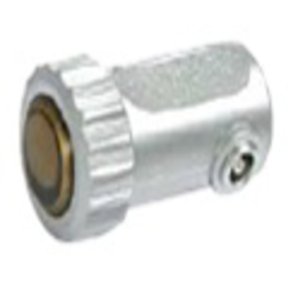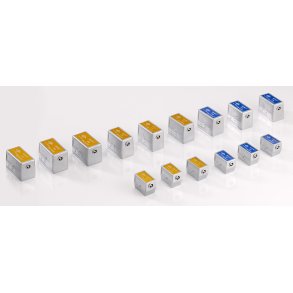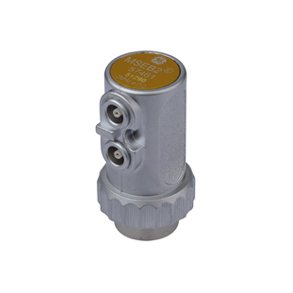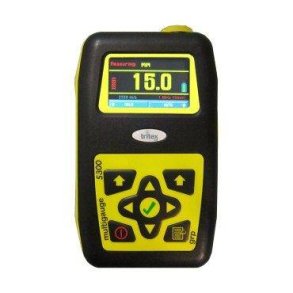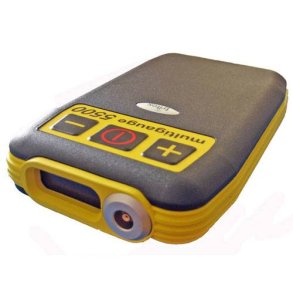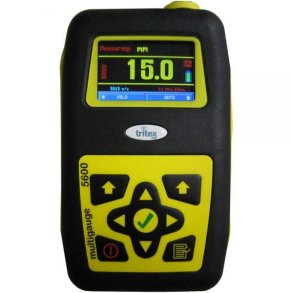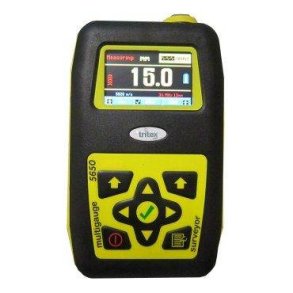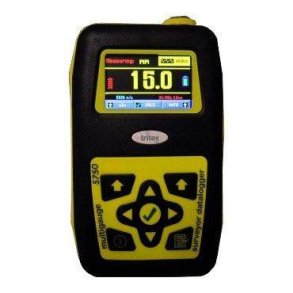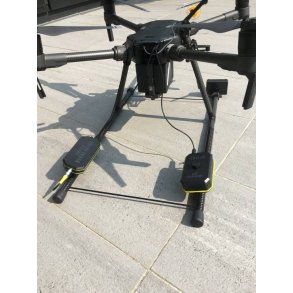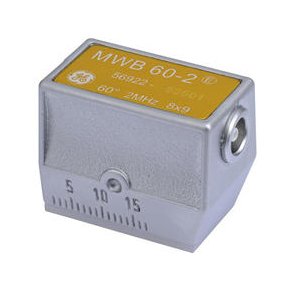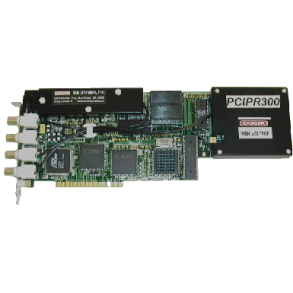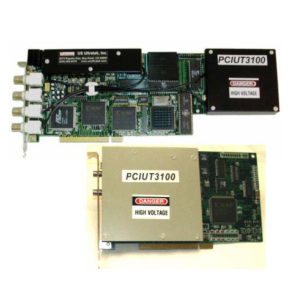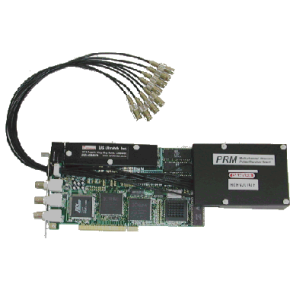Ultrasonic Testing (UT)
What is Ultrasonic Testing?
Ultrasonic testing using the pulse-echo method can be simply described as a type of material radar. A short pulse of very high-frequency mechanical vibrations is transmitted into the material. These vibrations are of the same nature as sound waves but are inaudible, hence they are called ultrasonic vibrations.
The pulses propagate through the material in a relatively narrow beam until they reach an interface, such as the opposite surface of the test object or an internal defect. From there, they are completely or partially reflected back to the transmitter, which now acts as a receiver. The time between transmitting a pulse depends on the distance traveled, as the propagation speed is constant for a given material type.
If a pulse is sent perpendicularly through a plate and the transit time is measured, the plate thickness can be calculated. Ultrasonic thickness gauges operate based on this principle.
If you want to locate internal defects in a test piece, you must know both the traveled distance and the point from which the ultrasonic pulse originates, as well as the direction it has traveled. Larger defects are mapped by moving the transducer, which emits and receives the ultrasonic pulses, across the surface of the object.
-
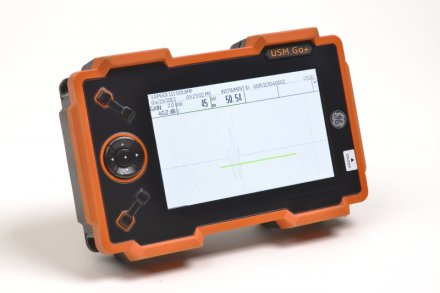 Ultrasonic Instruments
Ultrasonic Instruments
-
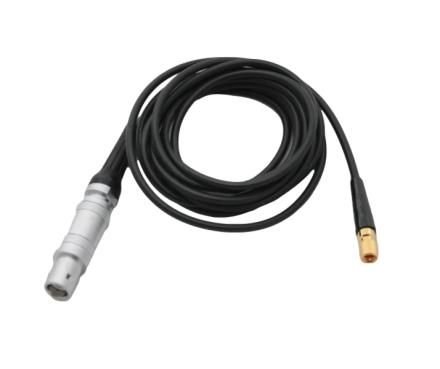 Cables
Cables
-
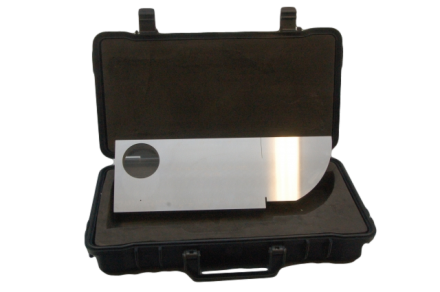 Reference Test Blocks
Reference Test Blocks
-
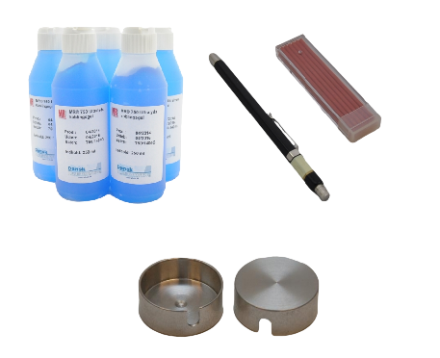 Misc. Equipment
Misc. Equipment
-
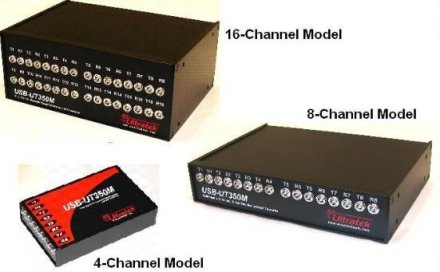 USB Instruments
USB Instruments
-
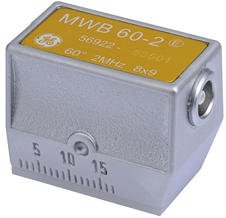 Waygate Technologies Ultrasonic Transducers
Waygate Technologies Ultrasonic Transducers
-
 Tru-Sonics Ultrasonic Transducers
Tru-Sonics Ultrasonic Transducers
-
 Ultrasonic Hardness Testers
Ultrasonic Hardness Testers
-
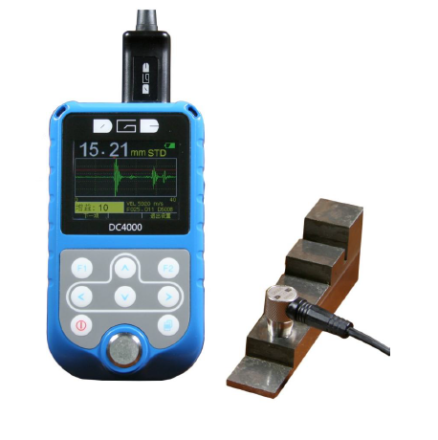 Thickness Measuring
Thickness Measuring
B 2 S
Waygate Technologies / Baker Hughes#57745
Series: B S
Bandwidth: 25
Frequency: 2 MHz
Conventional transducer
For price, contact us by Phone: (+45) 44 65 22 77 or Email: info@ndtvendor.com
B 4 S
Waygate Technologies / Baker Hughes#57746
Series: B S
Bandwidth: 25
Frequency: 4 MHz
Conventional transducer
For price, contact us by Phone: (+45) 44 65 22 77 or Email: info@ndtvendor.com
Compact Pulser
Dansk NDT Teknik A/S#CompactPulser
For price, contact us by Phone: (+45) 44 65 22 77 or Email: info@ndtvendor.com
Krautkramer USM 36
Waygate Technologies / Baker HughesUltrasonic device with large 7'' color display.
Extremely easy operation and long battery life of more than 13 hours.
For price, contact us by Phone: (+45) 44 65 22 77 or Email: info@ndtvendor.com
Krautkramer USN 60/60L
Waygate Technologies / Baker HughesDevice for extreme conditions. Approved for use down to -20 degrees Celsius as well as a high-resolution LCD color display.
For price, contact us by Phone: (+45) 44 65 22 77 or Email: info@ndtvendor.com
Krautkrämer RotoArray comPAct
Waygate Technologies / Baker Hughes#RotoArray-ComPAct
Advanced roller probe built directly into the handle. Ultra-compact PA probe.
For price, contact us by Phone: (+45) 44 65 22 77 or Email: info@ndtvendor.com
Krautkrämer USM GO+
Waygate Technologies / Baker HughesLatest USM Go+ with upgraded operation. An extremely compact instrument that can be operated single-handedly during the inspection. Weighs only 850 g including battery.
Datasets are easily stored via SD card, which can be moved directly from instrument to instrument.
For price, contact us by Phone: (+45) 44 65 22 77 or Email: info@ndtvendor.com
MB 2 S (E)
Waygate Technologies / Baker Hughes#57748
Series: MB S
Bandwidth: 25
Frequency: 2 MHz
Conventional transducer
For price, contact us by Phone: (+45) 44 65 22 77 or Email: info@ndtvendor.com
MB 4 S (E)
Waygate Technologies / Baker Hughes#57749
Series: MB S
Bandwidth: 25
Frequency: 4 MHz
Conventional transducer
For price, contact us by Phone: (+45) 44 65 22 77 or Email: info@ndtvendor.com
Mentor UT
Waygate Technologies / Baker HughesMentor UT is BHGE's latest phased array UT instrument.
Developed with a focus on corrosion mapping.
For price, contact us by Phone: (+45) 44 65 22 77 or Email: info@ndtvendor.com
MSEB 2 - 0°
Waygate Technologies / Baker Hughes#66158
Series: MSEB
Frequency: 2 MHz
Dual Transducer (TR probe)
For price, contact us by Phone: (+45) 44 65 22 77 or Email: info@ndtvendor.com
MSEB 2-E
Waygate Technologies / Baker Hughes#57461
Series: MSEB
Frequency: 2 MHz
Dual Transducer (TR probe)
For price, contact us by Phone: (+45) 44 65 22 77 or Email: info@ndtvendor.com
MSEB 4 - 0°
Waygate Technologies / Baker Hughes#57463
Series: MSEB
Frequency: 4 MHz
Dual Transducer (TR probe)
For price, contact us by Phone: (+45) 44 65 22 77 or Email: info@ndtvendor.com
MSEB 4-E
Waygate Technologies / Baker Hughes#57462
Series: MSEB
Frequency: 4 MHz
Dual Transducer (TR probe)
For price, contact us by Phone: (+45) 44 65 22 77 or Email: info@ndtvendor.com
Multigauge 5300 GRP Thickness Gauge
Tritex53-5300
Designed to check the condition of Glass Reinforced Plastic (GRP) or Engineering Plastics. It can also be used on uncoated metal.
€ 2,062
(excl. VAT)Multigauge 5350 GRP Thickness Meter
Tritex53-5350
The Multigauge 5350 GRP Thickness Meter is designed to check the condition of GRP, engineering plastics or metal. Measurements can be stored on the gauge and wirelessly transferred to the PC.
€ 2,616
(excl. VAT)Multigauge 5500 Waist
Tritex55-5500
The Multigauge 5500 metal thickness tester has been designed for hands free use when climbing on staging, scaffolding, ladders or when accessing by rope. It uses Multiple Echo to ignore coatings, measuring only the remaining metal thickness.
€ 1,987
(excl. VAT)Multigauge 5600 Hand Held
Tritex56-5600
The popular Multigauge 5600 ultrasonic thickness meter is a simple, robust thickness meter designed for most common thickness gauging applications. It uses Multiple Echo to ignore coatings, measuring only the metal thickness.
€ 2,054
(excl. VAT)Multigauge 5650 Surveyor Thickness Gauge
Tritex56-5650 SG
For ship and small craft surveyors, but can also be used in applications where different measurement modes are required. The user has a choice of Multiple Echo, Echo to Echo or Single Echo to cover all requirements. The gauge can be used for metal, GRP or plastic measurement.
Price from € 2,082
(excl. VAT)Multigauge 5750 Surveyor Datalogger Thickness Meter
Tritex57-5750
Used for ship and small craft surveyors, but can also be used in applications where different measurment modes are required. The user has a choice of Multiple Echo, Echo to Echo or Single Echo to cover all requirements. The gauge can be used for metal, GRP or plastic measurement. Measurements can be stored on the gauge and wirelessly transferred to the PC.
Price from € 2,680
(excl. VAT)Multigauge 6000 Drone Thickness Gauge
TritexThe Multigauge 6000 UT Drone Thickness Gauge has been specifically designed to mount onto drones or unmanned aerial vehicles (UAV)
For price, contact us by Phone: (+45) 44 65 22 77 or Email: info@ndtvendor.com
MWB 45-4 EN- 45°
Waygate Technologies / Baker Hughes#500048
EN Certificate included.
Series: MWB
Bandwidth: 30 - 60
Frequency: 4 MHz
Beam angle: 45°
For price, contact us by Phone: (+45) 44 65 22 77 or Email: info@ndtvendor.com
MWB 45-4E - 45°
Waygate Technologies / Baker Hughes#56927
Series: MWB
Bandwidth: 30 - 60
Frequency: 4 MHz
Beam angle: 45°
For price, contact us by Phone: (+45) 44 65 22 77 or Email: info@ndtvendor.com
MWB 60-4 EN- 60°
Waygate Technologies / Baker Hughes#500049
EN Certificate included.
Series: MWB
Bandwidth: 30 - 60
Frequency: 4 MHz
Beam angle: 60°
For price, contact us by Phone: (+45) 44 65 22 77 or Email: info@ndtvendor.com
MWB 60-4E - 60°
Waygate Technologies / Baker Hughes#56928
Series: MWB
Bandwidth: 30 - 60
Frequency: 4 MHz
Beam angle: 60°
For price, contact us by Phone: (+45) 44 65 22 77 or Email: info@ndtvendor.com
MWB 70-4 EN 70°
Waygate Technologies / Baker Hughes#500050
EN Certificate included.
Series: MWB
Bandwidth: 30 - 60
Frequency: 4 MHz
Beam angle: 70°
For price, contact us by Phone: (+45) 44 65 22 77 or Email: info@ndtvendor.com
MWB 70-4E - 70°
Waygate Technologies / Baker Hughes#56929
Series: MWB
Bandwidth: 30 - 60
Frequency: 4 MHz
Beam angle: 70°
For price, contact us by Phone: (+45) 44 65 22 77 or Email: info@ndtvendor.com
MWB 80-4E - 80°
Waygate Technologies / Baker Hughes#56930
Series: MWB
Bandwidth: 30 - 60
Frequency: 4 MHz
Beam angle: 80°
For price, contact us by Phone: (+45) 44 65 22 77 or Email: info@ndtvendor.com
PCIPR300
Dansk NDT Teknik A/S#PCIPR300
For price, contact us by Phone: (+45) 44 65 22 77 or Email: info@ndtvendor.com
PCIUT3100 All-in-One
Dansk NDT Teknik A/S#PCIUT3100
For price, contact us by Phone: (+45) 44 65 22 77 or Email: info@ndtvendor.com
PRM
Dansk NDT Teknik A/S#PRM
For price, contact us by Phone: (+45) 44 65 22 77 or Email: info@ndtvendor.com


_copy (1) (1)/assets/images/header/trustpilot.png)
